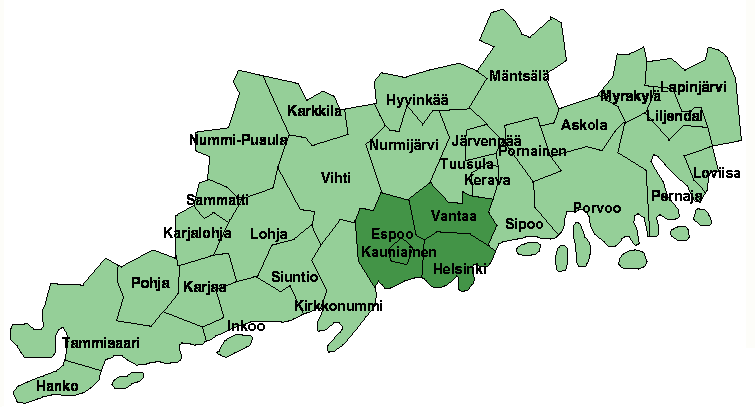Country Finland Time zone EET (UTC+2) NUTS 181 Area 9,568 km² | Historical province Uusimaa ISO 3166 code FI-18 - Nominal GDP(2016) €80 billion | |
 | ||
Destinations Helsinki, Porvoo, Nuuksio National Park, Espoo Clubs and Teams Helsingin Jalkapalloklubi, Jokerit, HIFK Colleges and Universities University of Helsinki, Laurea University of Applie, Aalto University, Diaconia University of Applie, Sibelius Academy Points of interest Suomenlinna, Seurasaari, Temppeliaukio Church, Helsinki Senate Square, Uspenski Cathedral - Helsinki | ||
A bicycle tour in western uusimaa finland
Uusimaa or Nyland ([ˈuːsimɑː]; [ˈnyːland]; both names mean “new land”) is a region in Finland. It borders the regions Southwest Finland, Tavastia Proper, Päijänne Tavastia and Kymenlaakso. Finland’s capital Helsinki (its largest city), its second largest city Espoo and its fourth largest city Vantaa are all located centrally in Uusimaa, making it by far the most populous region.
Contents
- A bicycle tour in western uusimaa finland
- Map of Uusimaa Finland
- History
- Languages
- Regional Council
- Municipalities
- Newspapers
- Radio stations
- Heraldry
- References
Map of Uusimaa, Finland
History
Uusimaa was, along with the rest of Southern and Western Finland, held by the Kingdom of Sweden from the 12th or 13th century. The coastal Uusimaa had earlier been sparsely populated, mostly by Tavastians, but was from the 12th century populated by Swedish settlers, mostly from Hälsingland, and Swedish-speaking villages came up near the mouths of Vantaanjoki and Keravanjoki. The Swedish placenames of Uusimaa date back to this period. However, there are traces of the older Tavastian placenames left in some names, like Konala which likely derives older name Konhola.
The names Uusimaa and Nyland mean “new land” in English. The Swedish-language name Nyland appears in the documents from the 14th century. The Finnish-language name Uusimaa appears for the first time in 1548 as Wsimaa in the first translation of the New Testament to Finnish by Mikael Agricola.
The Finnish provinces were ceded to Imperial Russia in the War of Finland in 1809. After this, Uusimaa became the Province of Uusimaa of the old lääni system. From 1997 to 2010, Uusimaa was a part of the Province of Southern Finland. It has been divided in the regions of Uusimaa and Eastern Uusimaa. In 2011, two regions were merged.
Languages
Uusimaa is an officially bilingual region, with both Finnish and Swedish having the same status. The region, especially coastal areas, is traditionally Swedish-speaking, the traditional regional dialects of Swedish (nyländska) are currently mostly spoken in Eastern Uusimaa, while in the rest of Uusimaa Swedish language became more standardised.
The Finnish-speaking population started to grow when the capital of the Grand Duchy of Finland was moved from Turku to Helsinki by Emperor of Russia Alexander I in 1812, and the region attracted settlers from other parts of Finland. Helsinki's slang, stadin slangi, first evolved in the late 19th century. 8.5% of population of the region speak Swedish language as native.
Regional Council
Is the main governing body for region and focueses primarily on urban planning. Like all regional councils it is mandated by law.
Municipalities
The region of Uusimaa is made up of 26 municipalities, of which 13 have city status (marked in bold).
Newspapers
The largest subscription newspapers published in the region are Helsingin Sanomat and Hufvudstadsbladet in Helsinki, Aamuposti in Hyvinkää, Länsi-Uusimaa in Lohja, Loviisan Sanomat and Östra Nyland in Loviisa, Uusimaa and Borgåbladet in Porvoo, Västra Nyland in Raseborg, and Keski-Uusimaa in Tuusula. Also two popular tabloid newspapers, Iltalehti and Ilta-Sanomat, are published there.
Radio stations
Yle's local radio stations in the western part of the region are Finnish-language Ylen läntinen and Swedish-language Yle Vega Västnyland, in the Capital Region Finnish-language Yle Radio Suomi Helsinki and Swedish-language Yle Vega Huvudstadsregionen, and in the eastern part Finnish-language Yle Radio Itä-Uusimaa and Swedish-language Yle Vega Östnyland.
Heraldry
The coat of arms of the region shows a yellow boat which is a symbol for the coastal areas, and two silver streams which are the symbol for rivers.
Uusimaa received its coat of arms at the end of the 16th century. There is an image of the coat of arms made in 1599. In 1997, the traditional coat of arms became the official coat of arms of the region.
